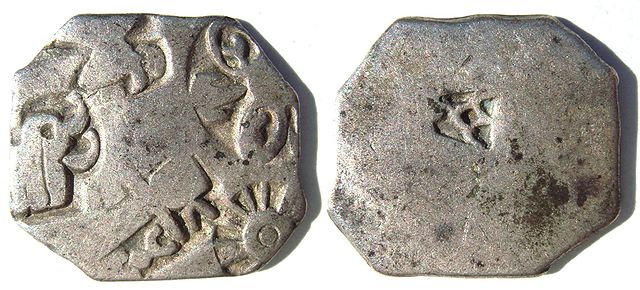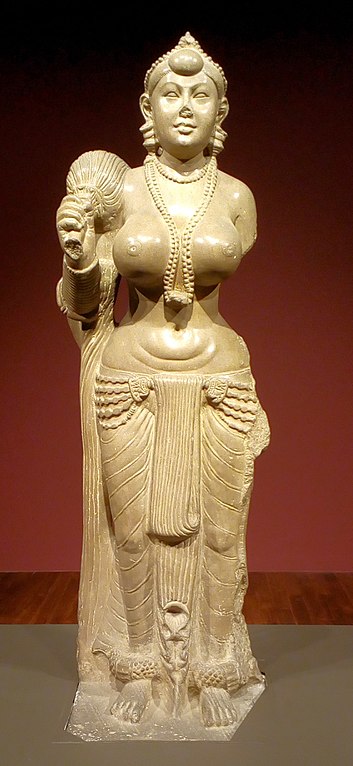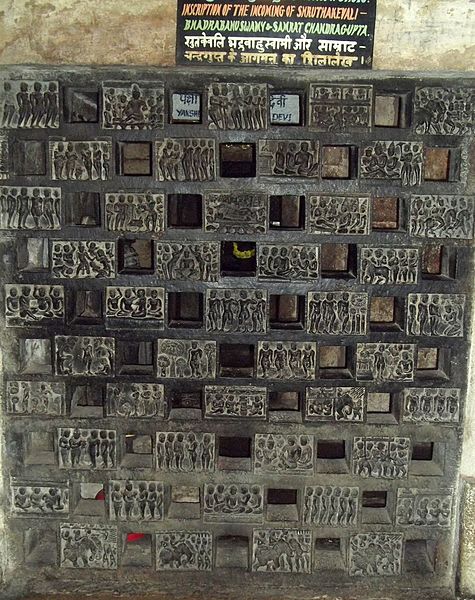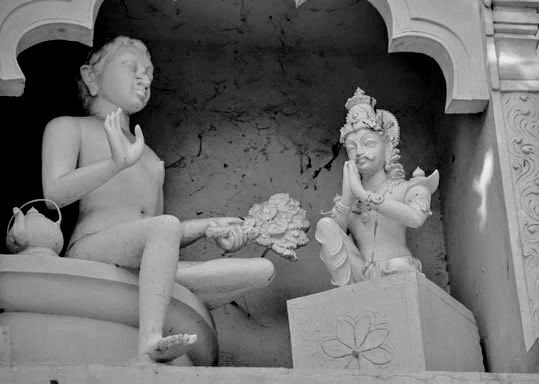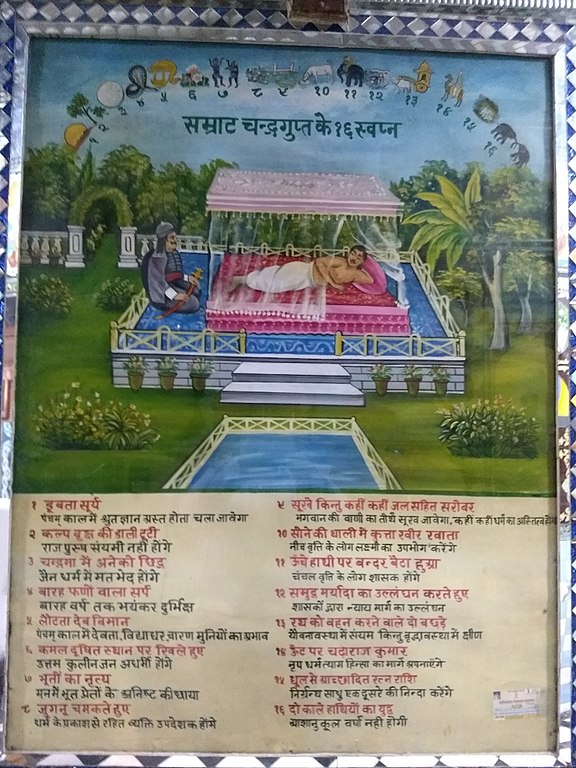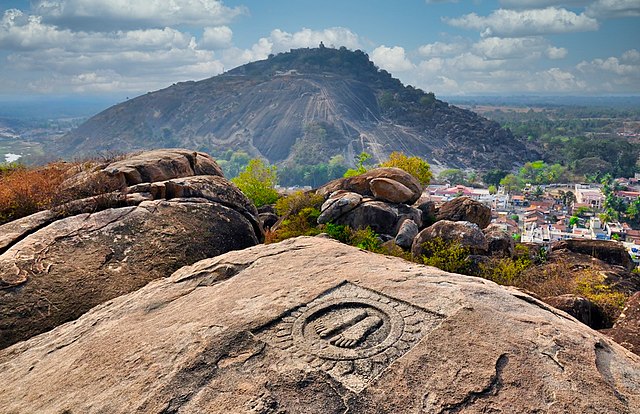
| CHANDRAGUPT MAURYA
Medieval stone relief at Digambara Jain pilgrimage site Shravanabelagola, Karnataka. It has been interpreted as Bhadrabahu and Chandragupta Maurya, but others disagree Chandragupta Maurya
1st
Mauryan Emperor
Maurya Empire (322 – 180 BCE) :
Chandragupta
: 322 – 297 BCE
Chandragupt Maurya (reign: 321–297 BCE) was the founder of the Maurya Empire in ancient India. He was taught and counselled by the philosopher Chanakya, who had great influence in the formation of his empire. Together, Chandragupt and Chanakya built one of the largest empires on the Indian subcontinent. According to Jain sources, he later renounced his empire and became a Jain monk. Chandragupt's life and accomplishments are described in ancient Greek, Hindu, Buddhist and Jain texts, but they vary significantly. In Ancient Greek and Latin accounts, Chandragupt is referred as Sandrokottos or Androcottus.
Chandragupt Maurya was a pivotal figure in the history of India, laying the foundations of the first government to unite most of South Asia. Chandragupt, under the tutelage of Chanakya, created a new empire based on the principles of statecraft, built a large army, and continued expanding the boundaries of his empire until ultimately renouncing it for an ascetic life in his final years.
Prior to his consolidation of power, Alexander the Great had invaded the North-West Indian subcontinent before abandoning his campaign in 324 BCE due to a mutiny caused by the prospect of facing another large empire, presumably the Nand Empire. Chandragupt defeated and conquered both the Nand Empire, and the Greek satraps that were appointed or formed from Alexander's Empire in South Asia. Chandragupt first gained regional prominence in the Greater Punjab region in the Indus. He then set out to conquer the Nand Empire centered in Pataliputra, Magadh. Afterwards, Chandragupt expanded and secured his western border, where he was confronted by Seleucus I Nicator in the Seleucid-Mauryan War. After two years of war, Chandragupt was considered to have gained the upper hand in the conflict and annexed satrapies up to the Hindu Kush. Instead of prolonging the war, both parties settled on a marriage alliance between Chandragupt and the daughter of Seleucus I Nicator instead.
Chandragupt's empire extended throughout most of the Indian subcontinent, spanning from modern day Bengal to Afghanistan across North India. As well as making inlays into Central and South India. According to historical Jain accounts, Chandragupt would renounce his throne to become a Jain monk, and would travel away from his empire to South India and committed sallekhana or fasting to death. Chandragupt's's reign, and the Maurya Empire, set an era of economic prosperity, reforms, infrastructure expansions, and tolerance. Many religions thrived within his realms and his descendants' empire. Buddhism, Jainism and Ajivika gained prominence alongside Vedic and Brahmanistic traditions, and minority religions such as Zoroastrianism and the Greek pantheon were respected. A memorial for Chandragupt Maurya exists on the Chandragiri hill along with a 7th-century hagiographic inscription.
Biography :
Statue of Chandragupt Maurya at Parliament of India Chandragupt's
life and accomplishments are described in ancient and historical
Greek, Hindu, Buddhist and Jain texts, though they significantly
vary in detail. The historical sources which describe the life of
Chandragupt Maurya vary considerably in details. His main biographical
sources in chronological order are :
The pre-4th century Hindu Puranic texts mostly mirror the Greek sources. These texts do not discuss the details of Chandragupt's ancestry, but rather cover the ancestry of the last Nand king. The Nand king is described to be cruel, against dharma and shastras, and born out of an illicit relationship followed by a coup. The Chanakya's Arthasastra refers to the Nand rule as against the spiritual, cultural and military interests of the country, a period where intrigue and vice multiplied. Chanakya states that Chandragupt returned dharma, nurtured a diversity of views and ruled virtuously that kindled love among the subjects for his rule.
Hindu sources are inconsistent. One medieval commentator states Chandragupt to be the son of one of the Nand's wives with the name Mura. Other sources describe Mura as a concubine of the king. Another Sanskrit dramatic text Mudrarakshasa uses the terms Vrishala and Kula-hina to describe Chandragupt. The word Vrishala has two meanings: one is the son of a Shudra; the other means the best of kings. A later commentator used the former interpretation to posit that Chandragupt had a Shudra background. However, historian Radha Kumud Mukherjee opposed this theory, and stated that the word should be interpreted as "the best of kings”. The same drama also refers to Chandragupt as someone of humble origin, in a manner similar to Justin. According to the 11th century texts of the Kashmiri Hindu tradition – Kathasaritsagara and Brihat-Katha-Manjari – the Nand lineage was very short. Chandragupt was a son of Purva-Nand, the older Nand based in Ayodhya. The common theme in the Hindu sources is that Chandragupt came from a humble background and with Chanakya he emerged as a dharmic king loved by his subjects.
The Buddhist texts such as Mahavamsa describe Chandragupt to be of Kshatriya origin. These sources, written about seven centuries after his dynasty ended, state that both Chandragupt and his grandson Ashok – a patron of Buddhism – were from a branch of the Shakya noble family, from which Gautama Buddha descended from. These Buddhist sources attempt to link the dynasty of their patron Ashok directly to the Buddha. The sources claim that the family branched off to escape persecution from a king of the Kosala Kingdom and Chandragupt's ancestors moved into a secluded Himalayan kingdom known for its peacocks. The Buddhist sources explain the epithet Moriya comes from these peacocks, or Mora in Pali (Sanskrit: Mayura). The Buddhist texts are inconsistent; some offer other legends to explain his epithet. For example, they mention a city named "Moriya-nagara" where all buildings were made of bricks colored like the peacock's neck. The Maha-bodhi-vamsa states he hailed from Moriya-nagara, while the Digh-Nikaya states he came from the Moriya clan of Pipphalivana. The Buddhist sources also mention that “Brahmin Chanakya” was his counselor and with whose support Chandragupt became the king at Patliputra.
7th-century Bhadrabahu inscription at Shravanabelagola (Sanskrit,
Purvahale Kannada script). This is the oldest inscription at the
site, and it mentions Bhadrabahu and Prabhacandra. Lewis Rice and
Digambara Jains interpret Prabhacandra to be Chandragupt Maurya,
while others such as J F Fleet, V. R. Ramachandra Dikshitar and
Svetambara Jains state this interpretation is wrong.
Date
:
The texts do not include the start or end year of Chandragupt's reign. According to some Hindu and the Buddhist texts, Chandragupt ruled for 24 years. The Buddhist sources state Chandragupt Maurya ruled 162 years after the death of the Buddha. However, the Buddha's birth and death varies by source and all these lead to a chronology that is significantly different than the Greek-Roman records. Similarly, Jain sources composed give different gaps between Mahavira's death and his accession. As with the Buddha's death, the date of Mahavira's death itself is also a matter of debate, and the inconsistencies and lack of unanimity among the Jain authors casts doubt on Jain sources. This Digambara Jain chronology, in addition, is not reconcilable with the chronology implied in other Indian and non-Indian sources.
Historians such as Irfan Habib and Vivekanand Jha assign Chandragupt's reign to c. 322-298 BCE. Upinder Singh dates his rule from 324 or 321 BCE to 297 BCE. Kristi Wiley states he reigned between 320 and 293 BCE.
Early
life :
According to the Digambar legend by Hemachandra, Chanakya was a Jain layperson and a Brahmin. When Chanakya was born, Jain monks prophesied that Chanakya will one day grow up to help make someone an emperor and will be the power behind the throne. Chanakya believed in the prophecy and fulfilled it by agreeing to help the daughter of a peacock breeding community chief deliver a baby boy. In exchange, he asked the mother to give up the boy and let him adopt him at a later date. The Jain Brahmin then went about making money through magic, and returned later to claim young Chandragupt, whom he taught and trained. Together, they recruited soldiers and attacked the Nand kingdom. Eventually, they won and proclaimed Patliputra as their capital.
Career
:
The Buddhist and Hindu sources present different versions of how Chandragupt met Chanakya. Broadly, they mention young Chandragupt creating a mock game of a royal court that he and his cowherd friends played. Chanakya saw him give orders to the others, bought him from the hunter, and adopted Chandragupt. Chanakya taught and admitted him in Taxila to study the Veds, military arts, law, and other sastras.
After Taxila, Chandragupt and Chanakya moved to Patliputra, the capital and a historic learning center in the eastern Magadh kingdom of India. They met Nand there according to Hindu sources, and Dhana Nand according to Pali-language Buddhist sources. Chandragupt became a commander of the Nand army, but according to Justin, Chandragupt offended the Nand king ("Nandrum" or "Nandrus") who ordered his execution. An alternate version states that it was the Nand king who was publicly insulted by Chanakya. Chandragupt and Chanakya escaped and became rebels who planned to remove the Nand king from power. [note 1] The Mudrarakshasa also states that Chanakya swore to destroy the Nand dynasty after he felt insulted by the king.
The Roman text by Justin mentions a couple of miraculous incidents that involved Sandracottus (Chandragupt) and presents these legends as omens and portents of his fate. In the first incident, when Chandragupt was asleep after having escaped from Nandrum, a big lion came up to him, licked him, and then left. In the second incident, when Chandragupt was readying for war with Alexander's generals, a huge wild elephant approached him and offered itself to be his steed.
Building
the empire :
The Buddhist Mahavamsa Tika and Jain Parishishtaparvan records Chandragupt's army unsuccessfully attacking the Nand capital. Chandragupt and Chanakya then began a campaign at the frontier of the Nand empire, gradually conquering various territories on their way to the Nand capital. He then refined his strategy by establishing garrisons in the conquered territories, and finally besieged the Nand capital Pataliputra. There Dhana nand accepted defeat, and was killed by Buddhist accounts, or deposed and exiled by Hindu accounts.
Conquest
of the Nand empire :
Historically reliable details of Chandragupt's campaign into Pataliputra are unavailable and legends written centuries later are inconsistent. Buddhist texts such as Milindapanha claim Magadh was ruled by the Nand dynasty, which, with Chanakya's counsel, Chandragupt conquered to restore dhamma. The army of Chandragupt and Chanakya first conquered the Nand outer territories before invading Pataliputra. In contrast to the easy victory in Buddhist sources, the Hindu and Jain texts state that the campaign was bitterly fought because the Nand dynasty had a powerful and well-trained army.
The conquest was fictionalised in Mudrarakshasa, in which Chandragupt is said to have first acquired Punjab and allied with a local king named Parvatka under the Chanakya's advice before advancing on the Nand Empire. Chandragupt laid siege to Kusumapura (now Patna), the capital of Magadh, by deploying guerrilla warfare methods with the help of mercenaries from conquered areas. Historian P. K. Bhattacharyya states that the empire was built by a gradual conquest of provinces after the initial consolidation of Magadh.
According to the Digambara Jain version by Hemachandra, the success of Chandragupt and his strategist Chanakya was stopped by a Nand town that refused to surrender. Chanakya disguised himself as a mendicant and found seven mother goddesses (saptamatrika) inside. He concluded these goddesses were protecting the town people. The townspeople sought the disguised mendicant's advice on how to end the blockade of the army surrounding their town. Hemacandra wrote Chanakya swindled them into removing the mother goddesses. The townspeople removed the protective goddesses and an easy victory over the town followed. Thereafter, the alliance of Chandragupt and Parvataka overran the Nand kingdom and attacked Patliputra with an "immeasurable army". With a depleted treasury, exhausted merit, and insufficient intelligence, the Nand king lost.
These legends state that the Nand king was defeated, but allowed to leave Pataliputra alive with a chariot full of items his family needed. The Jain sources attest that his daughter fell in love at first sight with Chandragupt and married him. With the defeat of Nand, Chandragupt Maurya founded the Maurya Empire in ancient India.
Conquest
of north-west regions :
The Indian campaign of Alexander the Great ended before Chandragupt came into power. Alexander had left India in 325 BCE and assigned the northwestern Indian subcontinent territories to Greek governors. The nature of early relationship between these governors and Chandragupt is unknown. Justin mentions Chandragupt as a rival of the Alexander's successors in north-western India. He states that after Alexander's death, Chandragupt freed Indian territories from the Greeks and executed some of the governors. According to Boesche, this war with the northwestern territories were in part fought by mercenaries hired by Chandragupt and Chanakya, and these wars may have been the cause of the demise of two of Alexander's governors, Nicanor and Philip. Megasthenes served as a Greek ambassador in his court for four years.
War
and marriage alliance with Seleucus :
R. C. Majumdar and D. D. Kosambi note that Seleucus appeared to have fared poorly after ceding large territories west of the Indus to Chandragupt. The Maurya Empire added Arachosia (Kandahar), Gedrosia (Balochistan), and Paropamisadae (Gandhar). [a] According to Strabo, Seleucus Nicator gave these regions to Chandragupt along with a marriage treaty, and in return received five hundred elephants. The details of the engagement treaty are not known. According to one version, the marriage treaty involved an Indian princess, while a different version states a Seleucid princess married into the Mauryan family.
Chandragupt sent 500 war elephants to Seleucus, which played a key role in Seleucus' victory at the Battle of Ipsus. In addition to this treaty, Seleucus dispatched Megasthenes as an ambassador to Chandragupt's court, and later Antiochos sent Deimakos to his son Bindusara at the Maurya court at Patna.
Southern
conquest :
Two poetic anthologies from the Tamil Sangam literature corpus – Akananuru and Purananuru – allude to the Nand rule and Maurya empire. For example, poems 69, 281 and 375 mention the army and chariots of the Mauryas, while poems 251 and 265 may be alluding to the Nands. However, the poems dated between 1st-century BCE to 5th-century CE do not mention Chandragupt Maurya by name, and some of them could be referring to a different Moriya dynasty in the Deccan region in the 5th century CE. According to Upinder Singh, these poems may be mentioning Mokur and Koshar kingdoms of Vadugars (northerners) in Karnataka and Andhra Pradesh, with one interpretation being that the Maurya empire had an alliance with these at some point of time.
Names and titles :
A modern statue depicting Chandragupt Maurya, Laxminarayan Temple, Delhi Greek writer Phylarchus (c. 3rd century BCE), who is quoted by Athenaeus, calls Chandragupt "Sandrokoptos". The later Greco-Roman writers Strabo, Arrian, and Justin (c. 2nd century) call him "Sandrocottus". In Greek and Latin accounts, Chandragupt is known as Sandrakottos and Androcottus.
The king's epithets mentioned in the Sanskrit play Mudrarakshas include "Chanda-siri" (Chandra-shri), "Piadamsan" (Priya-darshan), and Vrishal. Piadamsana is similar to Piyadasi, an epithet of his grandson Ashok. The word "Vrishal" is used in Indian epics and law books to refer to non-orthodox people. According to one theory, it may be derived from the Greek royal title Basileus, but there is no concrete evidence of this: the Indian sources apply it to several non-royals, especially wandering teachers and ascetics.
Empire
:
In the west, Chandragupt's rule over present-day Gujarat is attested to by Ashok's inscription in Junagadh. On the same rock, about 400 years later, Rudradaman inscribed a longer text sometime about the mid 2nd–century. Rudradaman's inscription states that the Sudarshana lake in the area was commissioned during the rule of Chandragupt through his governor Vaishya Pushyagupta and conduits were added during Ashok's rule through Tushaspha. The Mauryan control of the region is further corroborated by the inscription on the rock, which suggests that Chandragupt controlled the Malwa region in Central India, located between Gujarat and Pataliputra.
There is uncertainty about the other conquests that Chandragupt may have achieved, especially in the Deccan region of southern India. At the time of his grandson Ashok's ascension in c. 268 BCE, the empire extended up to present-day Karnataka in the south, so the southern conquests may be attributed to either Chandragupt or his son Bindusara. If the Jain tradition about Chandragupt ending his life as a renunciate in Karnakata is considered correct, it appears that Chandragupt initiated the southern conquest.
Maurya with his counsellor Chanakya together built one of the largest empires ever on the Indian subcontinent. Chandragupt's empire extended from Bengal to central Afghanistan encompassing most of the Indian subcontinent except for parts that are now Tamil Nadu, Kerala and Odisha.
Rule
:
The Maurya rule was a structured administration; Chandragupt had a council of ministers (amatya), with Chanakya was his chief minister. The empire was organised into territories (janapada), centres of regional power were protected with forts (durga), and state operations were funded with treasury (kosa). Strabo, in his Geographica composed about 300 years after Chandragupt's death, describes aspects of his rule in his chapter XV.46–69. He had councillors for matters of justice and assessors to collect taxes on commercial activity and trade goods. He routinely performed Vedic sacrifices, Brahmanical rituals, and hosted major festivals marked by procession of elephants and horses. His officers inspected situations requiring law and order in the cities; the crime rate was low.
According to Megasthenes, Chandragupt's rule was marked by three parallel administrative structures. One managed the affairs of villages, ensuring irrigation, recording land ownership, monitoring tools supply, enforcing hunting, wood products and forest-related laws, and settling disputes. Another administrative structure managed city affairs, including all matters related to trade, merchant activity, visit of foreigners, harbors, roads, temples, markets, and industries. They also collected taxes and ensured standardized weights and measures. The third administrative body overlooked the military, its training, its weapons supply, and the needs of the soldiers.
Chanakya was concerned about Chandragupt's safety and developed elaborate techniques to prevent assassination attempts. Various sources report Chandragupt frequently changed bedrooms to confuse conspirators. He left his palace only for certain tasks: to go on military expeditions, to visit his court for dispensing justice, to offer sacrifices, for celebrations, and for hunting. During celebrations, he was well-guarded, and on hunts, he was surrounded by female guards who were presumed to be less likely to participate in a coup conspiracy. These strategies may have resulted from the historical context of the Nand king who had come to power by assassinating the previous king.
During Chandragupt's reign and that of his dynasty, many religions thrived in India, with Buddhism, Jainism and Ajivika gaining prominence along with the Brahmanism traditions.
Infrastructure projects :
The empire built a strong economy from a solid infrastructure such as irrigation, temples, mines, and roads. Ancient epigraphical evidence suggests Chandragupt, under counsel from Chanakya, started and completed many irrigation reservoirs and networks across the Indian subcontinent to ensure food supplies for the civilian population and the army, a practice continued by his dynastic successors. Regional prosperity in agriculture was one of the required duties of his state officials.
The strongest evidence of infrastructure development is found in the Junagadh rock inscription of Rudradaman in Gujarat, dated to about 150 CE. It states, among other things, that Rudradaman repaired and enlarged the reservoir and irrigation conduit infrastructure built by Chandragupt and enhanced by Asok. Chandragupt's empire also built mines, manufacturing centres, and networks for trading goods. His rule developed land routes to transport goods across the Indian subcontinent. Chandragupt expanded "roads suitable for carts" as he preferred those over narrow tracks suitable for only pack animals.
Statue :
According to Kaushik Roy, the Maurya dynasty rulers were "great road builders". The Greek ambassador Megasthenes credited this tradition to Chandragupt after the completion of a thousand-mile-long highway connecting Chandragupt's capital Pataliputra in Bihar to Taxila in the north-west where he studied. The other major strategic road infrastructure credited to this tradition spread from Pataliputra in various directions, connecting it with Nepal, Kapilavastu, Dehradun, Mirzapur, Odisha, Andhra, and Karnataka. Roy stated this network boosted trade and commerce, and helped move armies rapidly and efficiently.
Chandragupt and Chanakya seeded weapon manufacturing centres, and kept them as a state monopoly of the state. The state, however, encouraged competing private parties to operate mines and supply these centres. They considered economic prosperity essential to the pursuit of dharma (virtuous life) and adopted a policy of avoiding war with diplomacy yet continuously preparing the army for war to defend its interests and other ideas in the Arthashastra.
Arts
and architecture :
Archeological discoveries in the modern age, such as those Didarganj Yakshi discovered in 1917 buried beneath the banks of the Ganges suggest exceptional artisanal accomplishment. The site was dated to 3rd century BCE by many scholars but later dates such as the Kushan era (1st-4th century CE) have also been proposed. The competing theories state that the art linked to Chandragupt Maurya's dynasty was learnt from the Greeks and West Asia in the years Alexander the Great waged war; or that these artifacts belong to an older indigenous Indian tradition. Frederick Asher of the University of Minnesota says "we cannot pretend to have definitive answers; and perhaps, as with most art, we must recognize that there is no single answer or explanation".
Succession, renunciation, and death (Sallekhana) :
1,300 years Old Shravanabelagola relief shows death of Chandragupt after taking the vow of Sallekhana. Some consider it about the legend of his arrival with Bhadrabahu
A statue depicting Chandrgupta Maurya (right) with his spiritual mentor Acharya Bhadrabahu at Shravanabelagola
Chandragupt Maurya having 16 auspicious dreams in Jainism The circumstances and year of Chandragupt's death are unclear and disputed. According to Digambara Jain accounts that, Bhadrabahu forecasted a 12-year famine because of all the killing and violence during the conquests by Chandragupt Maurya. He led a group of Jain monks to south India, where Chandragupt Maurya joined him as a monk after abdicated his kingdom to his son Bindusara. Together, states a Digambara legend, Chandragupt and Bhadrabahu moved to Shravanabelagola, in present-day south Karnataka. These Jain accounts appeared in texts such as Brihakatha kosa (931 CE) of Harishena, Bhadrabahu charita (1450 CE) of Ratnanandi, Munivamsa bhyudaya (1680 CE) and Rajavali kathe. Chandragupt lived as an ascetic at Shravanabelagola for several years before fasting to death as per the Jain practice of sallekhana, according to the Digambara legend.
In accordance with the Digambara tradition, the hill on which Chandragupt is stated to have performed asceticism is now known as Chandragiri hill, and Digambaras believe that Chandragupt Maurya erected an ancient temple that now survives as the Chandragupt basadi. According to Roy, Chandragupt's abdication of throne may be dated to c. 298 BCE, and his death to c. 297 BCE. His grandson was emperor Ashok who is famed for his historic pillars and his role in helping spread Buddhism outside of ancient India.
Regarding the inscriptions describing the relation of Bhadrabahu and Chandragupt Maurya, Radha Kumud Mookerji writes,
The oldest inscription of about 600 AD associated "the pair (yugma), Bhadrabahu along with Chandragupt Muni." Two inscriptions of about 900 AD on the Kaveri near Seringapatam describe the summit of a hill called Chandragiri as marked by the footprints of Bhadrabahu and Chandragupt munipati. A Shravanabelagola inscription of 1129 mentions Bhadrabahu "Shrutakevali", and Chandragupt who acquired such merit that he was worshipped by the forest deities. Another inscription of 1163 similarly couples and describes them. A third inscription of the year 1432 speaks of Yatindra Bhadrabahu, and his disciple Chandragupt, the fame of whose penance spread into other words.
Along with texts, several Digambara Jain inscriptions dating from the 7th–15th century refer to Bhadrabahu and a Prabhacandra. Later Digambara tradition identified the Prabhacandra as Chandragupt, and some modern era scholars have accepted this Digambara tradition while others have not, Several of the late Digambara inscriptions and texts in Karnataka state the journey started from Ujjain and not Patliputra (as stated in some Digambar texts).
Jeffery D. Long – a scholar of Jain and Hindu studies – says in one Digambara version, it was Samprati Chandragupt who renounced, migrated and performed sallekhana in Shravanabelagola. Long states scholars attribute the disintegration of the Maurya empire to the times and actions of Samprati Chandragupt – the grandson of Ashok and great-great-grandson of Chandragupt Maurya. The two Chandragupts have been confused to be the same in some Digambara legends.
Scholar of Jain studies and Sanskrit Paul Dundas says the Svetambara tradition of Jainism disputes the ancient Digambara legends. According to a 5th-century text of the Svetambara Jains, the Digambara sect of Jainism was founded 609 years after Mahavira's death, or in 1st-century CE. Digambaras wrote their own versions and legends after the 5th-century, with their first expanded Digambara version of sectarian split within Jainism appearing in the 10th-century. The Svetambaras texts describe Bhadrabahu was based near Nepalese foothills of the Himalayas in 3rd-century BCE, who neither moved nor travelled with Chandragupt Maurya to the south; rather, he died near Patliputra, according to the Svetambara Jains.
The 12th-century Svetambar Jain legend by Hemachandra presents a different picture. The Hemachandra version includes stories about Jain monks who could become invisible to steal food from royal storage and the Jain Brahmin Chanakya using violence and cunning tactics to expand Chandragupt's kingdom and increase royal revenues. It states in verses 8.415 to 8.435, that for 15 years as king, Chandragupt was a follower of non-Jain "ascetics with the wrong view of religion" (non-Jain) and "lusted for women". Chanakya, who was a Jain follower, persuaded Chandragupt to convert to Jainism by showing that Jain ascetics avoided women and focused on their religion. The legend mentions Chanakya aiding the premature birth of Bindusara, It states in verse 8.444 that "Chandragupt died in meditation (can possibly be sallekhana.) and went to heaven". According to Hemachandra's legend, Chanakya also performed sallekhan.
The Footprints of Chandragupt Maurya on Chandragiri Hill, where Chandragupt (the unifier of India and founder of the Maurya Dynasty) performed Sallekhana According to V. R. Ramachandra Dikshitar – an Indologist and historian, several of the Digambara legends mention Prabhacandra, whom had been misidentified as Chandragupt Maurya particularly after the original publication on Shravanabelagola epigraphy by B. Lewis Rice. The earliest and most important inscriptions mention Prabhacandra, which Rice presumed may have been the "clerical name assumed by Chadragupta Maurya" after he renounced and moved with Bhadrabahu from Patliputra. Dikshitar stated there is no evidence to support this and Prabhacandra was an important Jain monk scholar who migrated centuries after Chandragupt Maurya's death. Other scholars have taken Rice's deduction of Chandragupt Maurya retiring and dying in Shravanabelagola as the working hypothesis, since no alternate historical information or evidence is available about Chandragupt's final years and death.
Legacy
:
https://en.wikipedia.org/ |
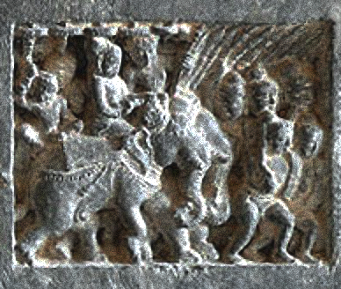
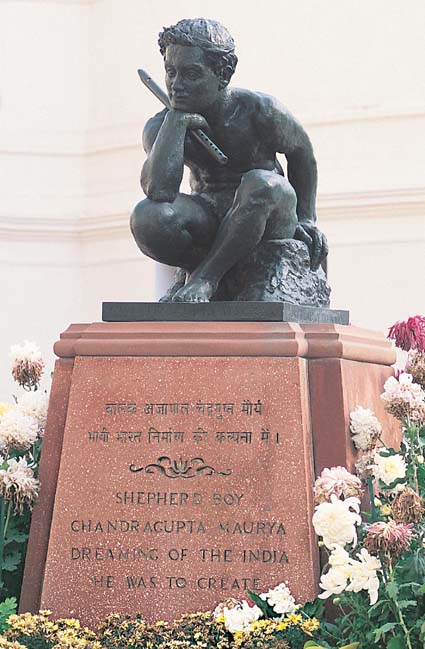
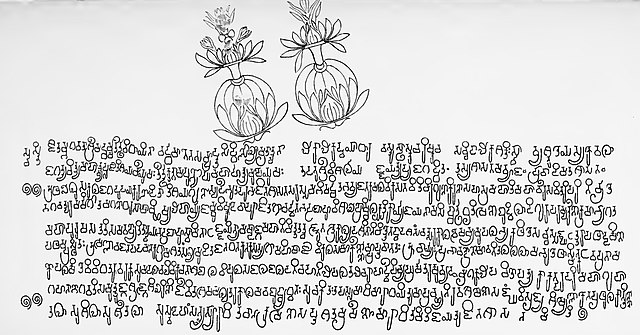
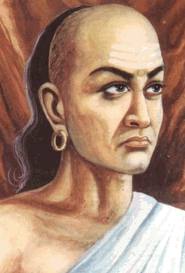
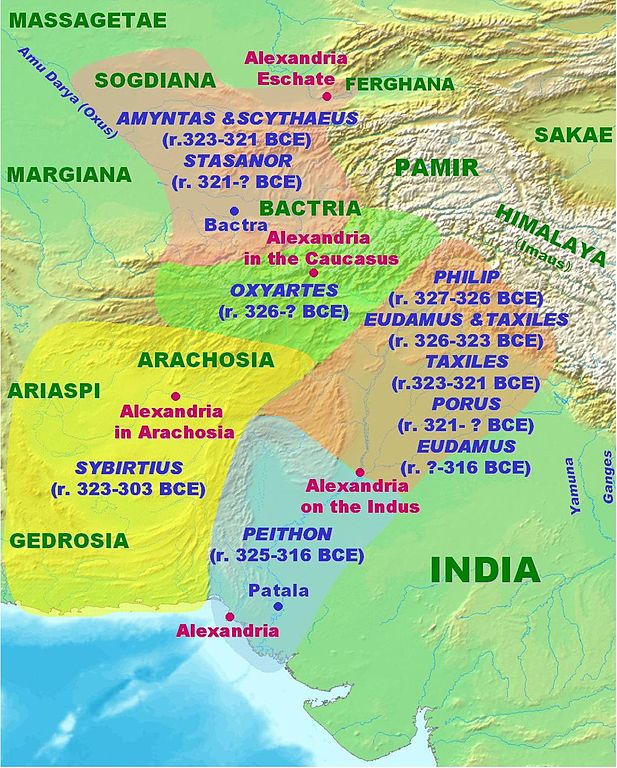
_(cropped).jpg)
